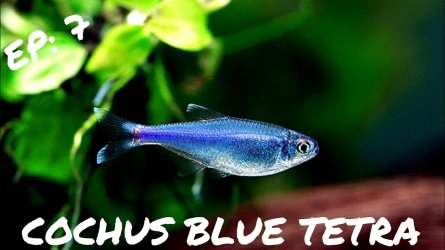I will copy over a profile of this species I wrote a few years back, it should explain things. This is not one of the most peaceful tetras, and does need numbers and space as it mentions in my article.
Boehlkea fredcochui
Family: Characidae, Sub-Family Stevardiinae
Common Names: Cochu Tetra, Blue Tetra
Origin and Habitat: Rio Maranon, Peru.
Compatibility/Temperament: Active but peaceful fish, suitable for a community aquarium with similar characins, danio, small catfish and loaches (soft, acidic water) or livebearers (slightly basic water). Must be kept in larger groups (9 or more) or it often turns feisty and may fin nip other fish.
Diet: Accepts prepared foods like flake and frozen.
Size: Grows to 2 inches.
Minimum Tank Suggestion: 30+ inches in length, this is an active swimmer and without sufficient space can turn feisty with other fish.
Water parameters:
Soft to moderately hard (hardness up to 15 dGH) acidic to slightly basic (pH up to 8.0) water, temperature 22-26C/72-79F. Will be more colourful in softer, slightly acidic water.
Description
Suitable for a planted tank that provides good swimming room; this fish remains in the mid to upper level of the aquarium. Must be in a group, preferably around 10-12 or more, and given enough space or it will harass other species. Subdued lighting will allow its beautiful blue colouration to shine.
Males are slimmer and more colourful. Spawning will occur in soft, acidic water, in the usual characin fashion.
The species was originally described by Gery (1966) as Hemibrycon fredcochui; in 1986, Ortega & Vari established it in the current genus as Boehlkea fredcochui (Gery 1966). It is currently the only species in the genus.
The genus Boehlkea was previously considered within the subfamily Tetragonopterinae, but this classification has for some time been deemed incertae sedis [Latin for "of uncertain placement"]. In a study published in 2010, it was determined that the subfamily Tetragonopterinae should only be used for species within the genus Tetragonopterus (Javonillo, et al, 2010). Also, Mirande (2009) has proposed several revisions to the Family Characidae based upon phylogenetic diagnosis. Some genera have been moved to a new subfamily, while others are now (temporarily) assinged to a specific clade within the family pending further study.
References:
Javonillo, Robert, Luiz R. Malabarba, Stanley H. Weitzman and John R. Burns (2010), "Relationships among major lineages of characid fishes (Teleostei: Ostariophysi: Characiformes), based on molecular sequence data," Molecular Phylogenetics and Evolution, Vol. 54, No. 2 (February 2010).
Mirande, J. Marcos (2009), "Weighted parsimony phylogeny of the family Characidae (Teleostei: Characiformes)," Cladistics, Vol. 25, No. 6 (July 2009).


